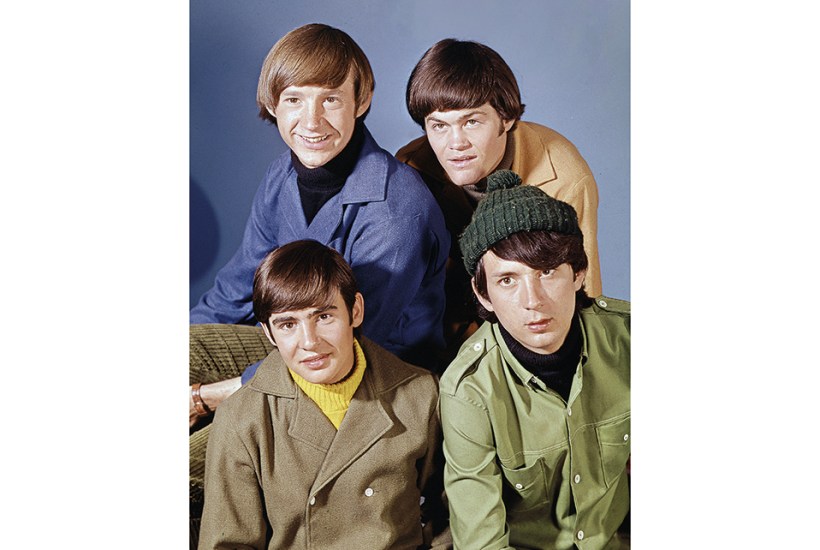Among those of a certain age, no pop group of the 1960s provokes a debate quite like the Monkees – neither the Beatles, who now represent the establishment they once threatened to overturn; nor the Rolling Stones, whose shock value resides in a shameless career of cultural appropriation rather than the pursuit of sex, drugs and rock’n’roll; nor the Who, half of whose members died before they got old, but who kept touring regardless.
These arguments about the Monkees can grow heated. The Rock and Roll Hall of Fame – the music industry-funded mausoleum located in Cleveland, Ohio – stubbornly refuses to recognise the contribution of ‘the Prefab Four’ on the spurious grounds that the hit-making combo was not ‘a real group’ but one put together for a television show. In a world of boy bands, synergies and cross-pollinations, quibbling over the relative merits of a (hugely successful) pop group seems not merely quaint but bizarre. Nearly six decades after they first hit TV screens, airwaves and the street, the Monkees still attract the funniest looks from everyone they meet.
In this book, Tom Kemper helps us understand what it is that continues to make the Monkees phenomenon ‘compelling, fascinating and divisive’:
Like any mythology or religion, the new rock criticism placed extreme emphasis on origins. Tracing an icon’s roots became a sacral measure of its authenticity, as in religious stories, mythologies and the new rock discourse; indeed, it became part of a band’s public relations. The Monkees emerged just at this moment… They are a product – a culmination – of the pop-rock industry as became both a complex system of industrial practices and an image of the values that informed the rock mythos: spontaneity, utopianism, liberalism.
As the title Made in Hollywood suggests, Kemper proposes that the Monkees were an integrated product of the Hollywood system – not only the coordination of talented individuals, from song-writers to musicians to producers, but also a business network encompassing the burgeoning music, film, television, radio and publishing industries. Furthermore, he locates the Monkees’ strengths and weaknesses geographically: a project made in Hollywood meant the city of Los Angeles itself, the thoroughfares, hang-outs and recording studios which allowed these scene-makers to be within walking or driving or hustling distance of each other. In time, it also meant a measure of hostility from every ambitious young gun who failed the TV show auditions, among them Stephen Stills, Paul Williams and Van Dyke Parks. Kemper’s decoding of the original ad that appeared in the LA trade papers Daily Variety and the Hollywood Reporter, calling for ‘Folk & Roll Musicians-Singers for acting roles in a new TV series’, specifically ‘spirited Ben Frank’s-types’, elucidates the subcultures that formed around the Ben Frank’s late-night diner on Sunset Strip: ‘a masterpiece of jet-age architecture, with its flying triangular ceiling… There is space here. Room to roam and relax, let go, connect, see and be seen.’ He also notes how an international, mass-media construct such as the Monkees drew much of its identity from highly localised roots and, lest we forget, the personalities of the Monkees themselves.
The names of Davy Jones, Micky Dolenz, Peter Tork and Michael Nesmith – cast in the TV series as Cute Monkee, Crazy Monkee, Dumb Monkee and Bobble-Hat Monkee – barely figure in the opening chapters of the book. Yet without them it seems unlikely the enterprise would have enjoyed such extra-ordinary success. Like any ‘real’ group, the whole was greater than the sum of the parts. Whatever credibility the band enjoyed, on screen or on disc, derived from their chemistry, even if it had been synthesised in a showbiz laboratory.
Kemper is not much concerned with the Monkees’ artistry, individual or combined, however, preferring instead to recognise what he refers to as ‘the genius of the system’:
The system responded to the troubles of the Monkees by preserving its overall operations. The system, for all its supportive structure, offered no allegiance to any one act. Each component adhered to its own roles and interests.
While this is a reasonable analysis of the mechanics of the project, one might equally apply it to the Banana Splits, S Club 7 or any prefabricated pop group with its own TV show, YouTube channel or social media following. Where Kemper distinguishes himself is in demonstrating how the group represented the spirit both of their time and place.
The Monkees may not reside in the Rock and Roll Hall of Fame alongside the Doors, the Byrds and Buffalo Springfield – all manufactured boy bands from LA – but no matter. Despite no longer being the young generation, they’ve still got something to say.
Got something to add? Join the discussion and comment below.
Get 10 issues for just $10
Subscribe to The Spectator Australia today for the next 10 magazine issues, plus full online access, for just $10.
You might disagree with half of it, but you’ll enjoy reading all of it. Try your first month for free, then just $2 a week for the remainder of your first year.








Comments
Don't miss out
Join the conversation with other Spectator Australia readers. Subscribe to leave a comment.
SUBSCRIBEAlready a subscriber? Log in